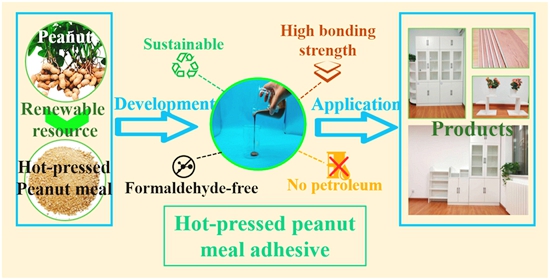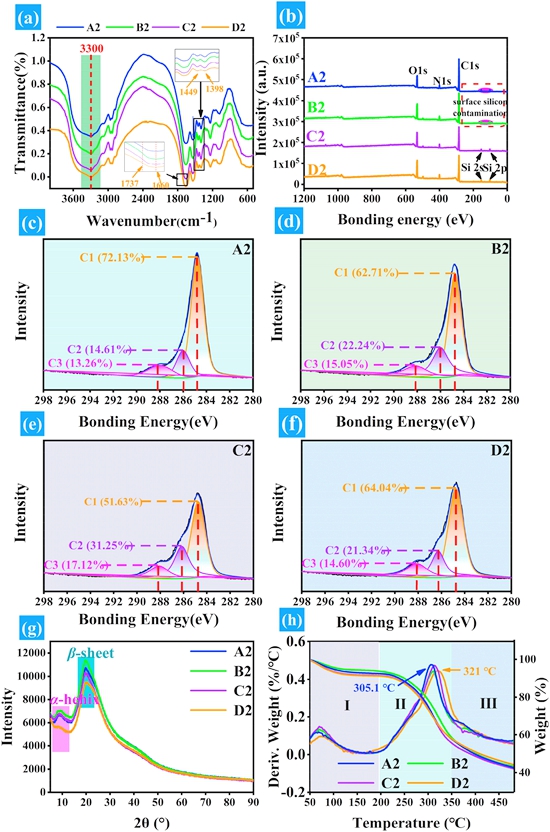A Novel Environmentally Friendly Hot-pressed Peanut Meal Protein Adhesive
Recently, the innovation team for plant protein structure and function regulation of the Institute of Food Science and Technology of the Chinese Academy of Agricultural Sciences (IFST, CAAS), has used hot-pressed peanut meal (HPM) as a raw material for HPM protein (HPMP) adhesive preparation using a three-step method of sodium dodecyl sulfate (SDS) denaturation, nano-silica (nSiO2) reinforcement and polyamide polyamine epichlorohydrin resin (PAE) crosslinking. The physical properties of HPMP adhesive and HPM protein isolated (HPMPI) adhesive were evaluated, and the preparation mechanism was further discussed using HPMPI adhesives. The relevant research results were published in the Journal of Cleaner Production with the title “A novel environmentally friendly hot-pressed peanut meal protein adhesive”.
China is the world's largest producer and trader of wood products. The common adhesives used in the wood-based panel industry are mainly "three-formaldehyde" adhesives (urea formaldehyde resin adhesive, melamine formaldehyde resin adhesive, phenolic resin adhesive). Moreover, formaldehyde is released during production, circulation and furniture use. With the continuous decline in petroleum production and growing awareness of environmental protection and safety, plant protein for the wood products industry, has become a new trend in the home improvement industry. However, the practical applications of these plant protein-based adhesives are limited by high cost, unsatisfactory bonding strength, low water resistance and mildew resistance. In this study, a green strategy for the production of a biobased, cost-effective, and formaldehyde-free HPMP adhesive was developed. The boiling water strength (0.85 MPa) of HPMP adhesive exceeded the bonding strength requirement of China National Standards class Ⅰ plywood, and the mildew resistance of HPMP adhesive was extended at least 12 days. In addition, the solids content and viscosity of HPMP adhesive increased by 45.4% and 274.6% respectively, which met the operational requirement for plywood production. The improved bonding strength and water resistance were mainly from the ring network structure formed by hydrogen bond, ester bond, ether bond and other bonds. This study demonstrated that the use of HPM to prepare adhesives was an effective approach for the generation of formaldehyde-free bio-adhesives with better performance and improved sustainability.
PhD student Qu Yang and associate researcher Guo Qin are co-first authors, and researcher Wang Qiang are the corresponding author. This work was funded by the research and development plan of Xinjiang Autonomous Region (2021B02003-3), Subei science and technology special fund (XZ-SZ202036), science and technology innovation project of Chinese Academy of Agricultural Sciences (CAAS-ASTIP-201X-IAPPST).

Fig.1 Graphical abstract

Fig.2 (a) FTIR spectrum. (b) wide XPS spectra. (c-f) C1s core levels XPS spectra. (g) XRD patterns. (h) DTG curves of A2- pure HPMPI adhesive, B2- SDS/HPMPI adhesive, C2- SDS/nSiO2/HPMPI adhesive, D2- HPMPI adhesive
Link to the paper:
https://www.sciencedirect.com/science/article/pii/S0959652621036520?via=ihub
By Guo Qin (guoqin@caas.cn)
-
 Apr 18, 2024Opening Ceremony of the Training Workshop on Wheat Head Scab Resistance Breeding and Pest Control in Africa Held in CAAS
Apr 18, 2024Opening Ceremony of the Training Workshop on Wheat Head Scab Resistance Breeding and Pest Control in Africa Held in CAAS -
 Apr 03, 2024IPPCAAS Co-organized the Training Workshop on Management and Application of Biopesticides in Nepal
Apr 03, 2024IPPCAAS Co-organized the Training Workshop on Management and Application of Biopesticides in Nepal -
 Mar 28, 2024Delegation from the School of Agriculture and Food Science of University College Dublin, Ireland Visit to IAS, CAAS
Mar 28, 2024Delegation from the School of Agriculture and Food Science of University College Dublin, Ireland Visit to IAS, CAAS -
 Mar 25, 2024Director of World Food Prize Foundation visited GSCAAS
Mar 25, 2024Director of World Food Prize Foundation visited GSCAAS -
 Mar 20, 2024Institute of Crop Sciences (ICS) and Syngenta Group Global Seeds Advance Collaborative Research in the Seed Industry
Mar 20, 2024Institute of Crop Sciences (ICS) and Syngenta Group Global Seeds Advance Collaborative Research in the Seed Industry
